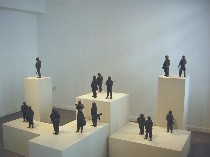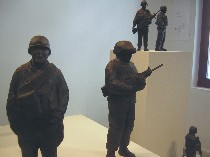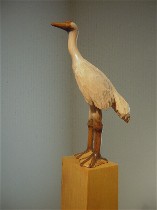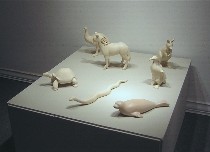
Susan Hagen’s soldiers at SchmidtDean are not to be missed. So go for both Hagen and Anne Seidman (see post) and have a nice conversation with yourself about realism and abstraction.
Hagen’s small black soldier figures carved of linden wood and then charred and oiled moved me to tears.
 If material and subject are one in art, these are indeed one. The blackened surfaces suggest stealth soldiers as well as destroyed soldiers as well as invisible soldiers, and indeed the real ones are all these things. If you’re wondering about invisible, I mean invisible to those who hold them dear, invisible to those who go about their everyday lives while these men are off, out of sight and often out of mind.
If material and subject are one in art, these are indeed one. The blackened surfaces suggest stealth soldiers as well as destroyed soldiers as well as invisible soldiers, and indeed the real ones are all these things. If you’re wondering about invisible, I mean invisible to those who hold them dear, invisible to those who go about their everyday lives while these men are off, out of sight and often out of mind.
The choices of outfits–one wearing a gas mask, one burdened with a giant pack on his back, etc.–and their size (approximately 12″ x 4″ x 4″)–evoke children and the vulnerability of the humans beneath the uniforms. They are only a notch larger than toys–enough to transcend the reference and to make the reference at the same time. This is every mother’s nightmare.
 Nor are the soldiers so different in subject from the work in the back room, two series, “Animalia Rarissima” and “Animalia Exstincta.” The 12 Rarissimas are tinted linden, showing they are still alive, but their balancing act on top of little unique pedestals suggests danger. My favorite Rarissima is “Whooping Crane” with the almost comical legs–no doubt partly a product of needing a strong enough base to stand.
Nor are the soldiers so different in subject from the work in the back room, two series, “Animalia Rarissima” and “Animalia Exstincta.” The 12 Rarissimas are tinted linden, showing they are still alive, but their balancing act on top of little unique pedestals suggests danger. My favorite Rarissima is “Whooping Crane” with the almost comical legs–no doubt partly a product of needing a strong enough base to stand.
 The Exstinctas, also of linden, are carved and bleached white and bone-like, suggesting a comparison and contrast with the charred soldiers. The soldiers are standing on their own two feet, even though they are burdened and endangered and endangering others. The Exstinctas are lying or standing loose on a large pedestal without individual bases. For them the balancing act is over. They’re gone.
The Exstinctas, also of linden, are carved and bleached white and bone-like, suggesting a comparison and contrast with the charred soldiers. The soldiers are standing on their own two feet, even though they are burdened and endangered and endangering others. The Exstinctas are lying or standing loose on a large pedestal without individual bases. For them the balancing act is over. They’re gone.









